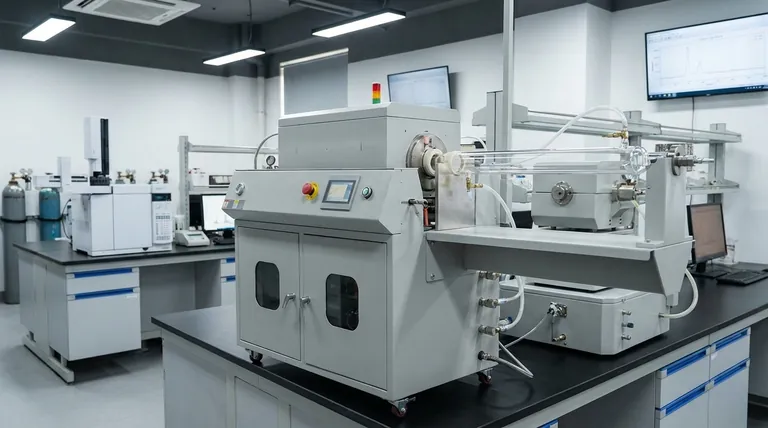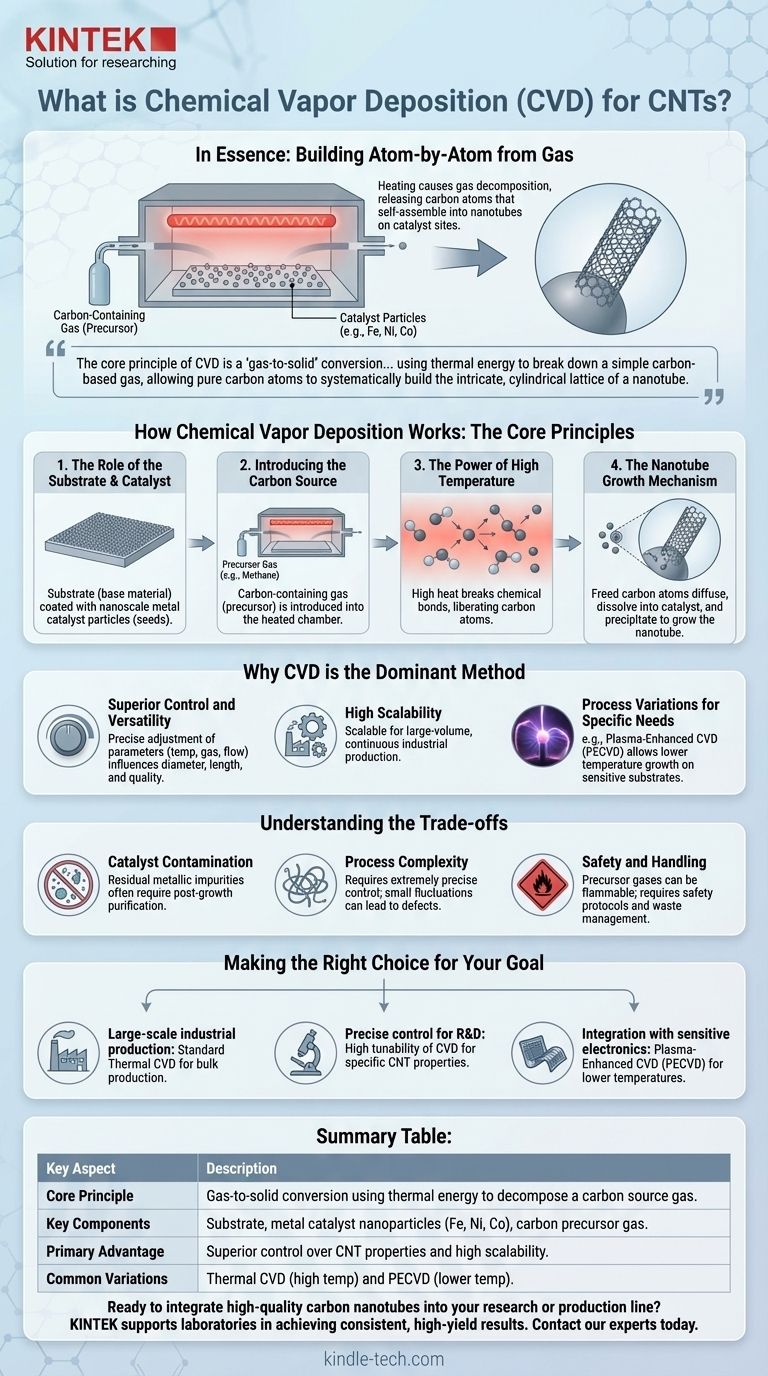In essence, Chemical Vapor Deposition (CVD) is a method for building carbon nanotubes (CNTs) atom-by-atom from a gas. It involves heating a surface coated with catalyst particles inside a chamber and then introducing a carbon-containing gas. The high temperature causes the gas to decompose, releasing carbon atoms that then self-assemble into nanotube structures on the catalyst sites.
The core principle of CVD is a "gas-to-solid" conversion. For carbon nanotubes, this means using thermal energy to break down a simple carbon-based gas, allowing pure carbon atoms to systematically build the intricate, cylindrical lattice of a nanotube on a prepared surface.

How Chemical Vapor Deposition Works: The Core Principles
To truly understand CVD, we must look at it as a controlled, multi-step process. Each step is critical for synthesizing high-quality nanotubes with specific properties.
The Role of the Substrate and Catalyst
The entire process begins with a base material, known as a substrate. This is the surface upon which the nanotubes will grow.
Crucially, for CNT growth, this substrate is coated with a thin layer of nanoscale catalyst particles, typically metals like iron, nickel, or cobalt. These particles are the actual "seeds" from which each nanotube originates and grows.
Introducing the Carbon Source
Once the substrate is heated to the target temperature inside a reaction chamber, a carbon-containing gas (known as a precursor) is introduced.
Common precursor gases include methane, ethylene, or acetylene. The choice of gas is a key experimental variable that influences the quality and type of nanotubes produced.
The Power of High Temperature
Heat is the engine of the CVD process. The high temperatures inside the chamber (often 600-1200°C) provide the necessary energy to break the chemical bonds within the precursor gas molecules.
This decomposition reaction effectively liberates carbon atoms from the gas, making them available for deposition.
The Nanotube Growth Mechanism
The freed carbon atoms diffuse towards the heated substrate and dissolve into the metal catalyst nanoparticles.
When the catalyst particle becomes supersaturated with carbon, the carbon begins to precipitate out in a highly organized, cylindrical, graphitic form. This precipitation is the growth of the carbon nanotube.
Why CVD is the Dominant Method
While older methods like arc discharge and laser ablation exist, CVD has become the dominant commercial and research process for producing CNTs. This is due to several distinct advantages.
Superior Control and Versatility
The CVD process offers unparalleled control over the final product. By precisely adjusting parameters like temperature, gas composition, pressure, and flow rate, researchers can influence the nanotubes' diameter, length, and quality (e.g., single-walled vs. multi-walled).
High Scalability
Unlike other methods, CVD systems can be scaled up for large-volume, continuous production. This scalability is the primary reason it has become the standard for industrial applications, where large quantities of CNTs are required.
Process Variations for Specific Needs
The fundamental principles of CVD can be adapted. For example, Plasma-Enhanced CVD (PECVD) uses an electric field to create plasma, which helps decompose the precursor gas.
This allows the reaction to occur at much lower temperatures, making it possible to grow CNTs directly on sensitive substrates (like plastics or certain electronics) that cannot withstand the heat of traditional CVD.
Understanding the Trade-offs
Despite its advantages, CVD is not without its challenges. Understanding these is key to its successful implementation.
Catalyst Contamination
Because nanotubes grow directly from metal catalyst particles, the final product often contains residual metallic impurities. Post-growth purification steps are almost always required, adding complexity and cost to the process.
Process Complexity
Achieving high-quality, uniform CNTs requires extremely precise control over multiple variables. Small fluctuations in temperature or gas flow can lead to defects in the nanotube structure or inconsistent batch quality.
Safety and Handling
The precursor gases used in CVD (like methane and acetylene) are often flammable and require specialized handling and safety protocols. The process also generates waste byproducts that must be managed properly.
Making the Right Choice for Your Goal
The optimal approach depends entirely on your end objective.
- If your primary focus is large-scale industrial production: Standard thermal CVD is the established, scalable, and most cost-effective method for producing CNTs in bulk.
- If your primary focus is precise control for R&D: The high tunability of CVD parameters makes it the ideal platform for researching and fabricating specific types of CNTs with desired properties.
- If your primary focus is integration with sensitive electronics: A lower-temperature variation like Plasma-Enhanced CVD (PECVD) is the necessary choice to avoid damaging the underlying components.
Ultimately, Chemical Vapor Deposition provides a robust and adaptable platform for creating one of the most remarkable materials ever discovered.
Summary Table:
| Key Aspect | Description |
|---|---|
| Core Principle | Gas-to-solid conversion using thermal energy to decompose a carbon source gas. |
| Key Components | Substrate, metal catalyst nanoparticles (e.g., Fe, Ni, Co), and a carbon precursor gas (e.g., methane). |
| Primary Advantage | Superior control over CNT properties (diameter, length, quality) and high scalability for industrial production. |
| Common Variations | Thermal CVD (high temp) and Plasma-Enhanced CVD (PECVD) for lower-temperature growth on sensitive materials. |
Ready to integrate high-quality carbon nanotubes into your research or production line? The precise control and scalability of CVD are essential for success. KINTEK specializes in providing the lab equipment and consumables needed for reliable CNT synthesis. Our expertise supports laboratories in achieving consistent, high-yield results. Contact our experts today to discuss how we can meet your specific laboratory needs.
Visual Guide

Related Products
- Customer Made Versatile CVD Tube Furnace Chemical Vapor Deposition Chamber System Equipment
- Split Chamber CVD Tube Furnace with Vacuum Station Chemical Vapor Deposition System Equipment Machine
- 1200℃ Split Tube Furnace with Quartz Tube Laboratory Tubular Furnace
- 1700℃ Laboratory Quartz Tube Furnace with Alumina Tube Tubular Furnace
- High Pressure Laboratory Vacuum Tube Furnace Quartz Tubular Furnace
People Also Ask
- What is the floating catalyst method? A Guide to High-Yield CNT Production
- How does chirality affect carbon nanotubes? It Determines If They Are Metal or Semiconductor
- What is a CVD tube furnace? A Complete Guide to Thin-Film Deposition
- What are nanotubes drawbacks? The 4 Major Hurdles Limiting Their Real-World Use
- How high of temperature do carbon nanotubes in air have the ability to sustain? Understanding the Oxidation Limit



















